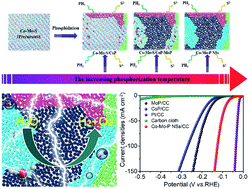Engineering multinary heterointerfaces in two-dimensional cobalt molybdenum phosphide hybrid nanosheets for efficient electrocatalytic water splitting†
Abstract
Heterointerface engineering produces a marked effect for regulating the surface and interfacial properties of a catalyst. However, effective manipulation of the quantity and quality of heterointerfaces in two-dimensional (2D) lateral nanoscale is still an extremely urgent but daunting task. Herein, cobalt molybdenum phosphide hybrid nanosheets (Co–Mo–P NSs) are tactfully constructed via a successive phosphidation strategy. The as-created multinary heterointerfaces and their synergistic effects can optimize the hydrogen adsorption/desorption energy (ΔGH*), as evidenced by density functional theory calculations, and improve the reaction kinetics. Moreover, the unique ultrathin nanosheet can maximize the exposure of interior atoms and heterointerfaces as reaction sites for catalysis, thus co-facilitating intrinsic catalytic activities. As an encouraging result, the optimized Co–Mo–P NSs exhibit considerable hydrogen evolution reaction (HER) performance, particularly with a 5.5 and 3.0 times higher turnover frequency than bare MoP and CoP, respectively. Moreover, it also exhibits superior oxygen evolution reaction (OER) activity (η10 = 261.9 mV) and profound full water decomposition behavior. This research proposes a facile strategy to controllably construct multinary heterointerfaces within 2D transition metal phosphide nanosheets, which might provide new insights into designing other advanced electrocatalysts.



 Please wait while we load your content...
Please wait while we load your content...